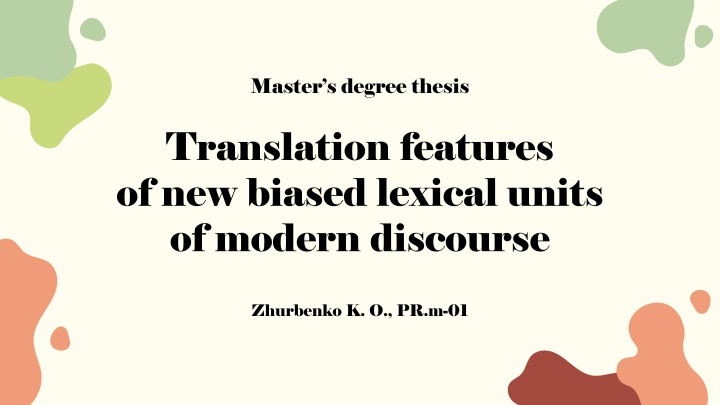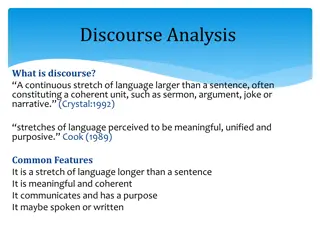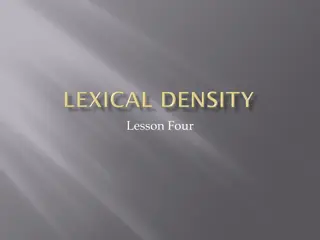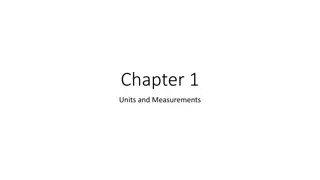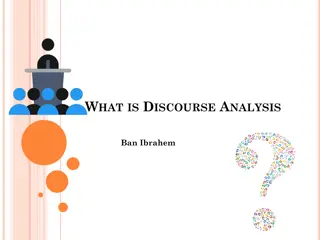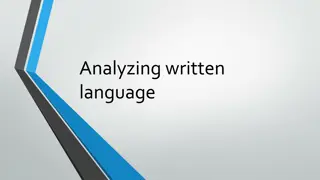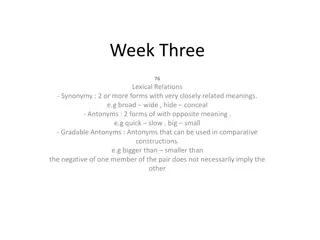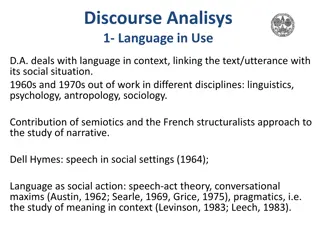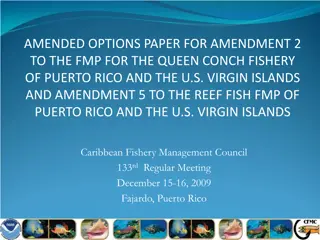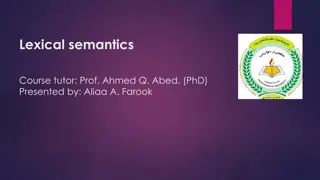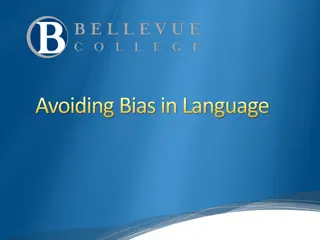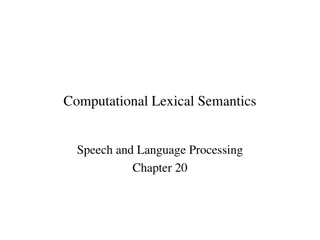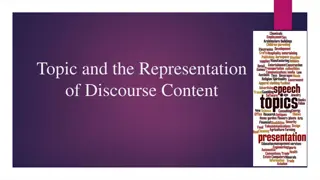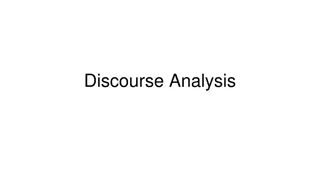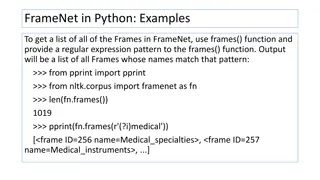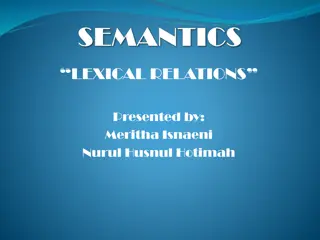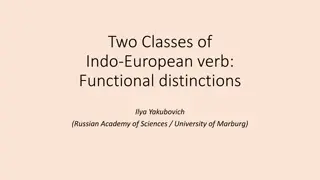Features of Biased Lexical Units in Modern Discourse
This Master's degree thesis delves into the linguistic, translation, and educational aspects of new biased vocabulary, focusing on neologisms, slang, and negative connotations. The study aims to analyze translation methods and create learning exercises for biased lexical items.
Download Presentation

Please find below an Image/Link to download the presentation.
The content on the website is provided AS IS for your information and personal use only. It may not be sold, licensed, or shared on other websites without obtaining consent from the author.If you encounter any issues during the download, it is possible that the publisher has removed the file from their server.
You are allowed to download the files provided on this website for personal or commercial use, subject to the condition that they are used lawfully. All files are the property of their respective owners.
The content on the website is provided AS IS for your information and personal use only. It may not be sold, licensed, or shared on other websites without obtaining consent from the author.
E N D
Presentation Transcript
Masters degree thesis Translation features of new biased lexical units of modern discourse Zhurbenko K. O., PR.m-01
Goal of the study to study the linguistic, translation and educational aspects of new biased vocabulary. Tasks of the study: consider the theoretical foundations of the concept of neologism , slang , euphemism ; define the concepts of neologism and social neologism , compare them; define the concept of slang ; to distinguish between the concepts of neologism and slang ; describe the phenomenon of new biased vocabulary; explore the concept of negative connotation ; analyze the translation of selected lexical items and conditionally group them; create a set of exercises for learning to translate biased lexical items.
The object of the study social neologisms and slang of modern English-language discourse, which can be biased. The subject of the study translation features and methods of teaching translation of social neologisms and slang of modern English discourse. The material of the study a sample of terms and concepts that define the social characteristics of a person, group of people and the mood of society.
Methods of the study: the method of induction the method of deduction the comparative method the method of continuous sampling methods of analysis
New biased lexis a set of lexical units that are biased and cause ambiguous (including attitudes among people negative)
Social neologisms 01 01 New biased lexis 02 02 Slang
Neologism a new word or a phrase (general definition) Neologism word or phrase specially created for the name of a particular subject or expression of a new concept, linguistic innovation, individual lexical unit in its form and meaning or new, derived or not derived from the previous, meaning of a language unit added to an existing one that was not fixed dictionaries, which arises for communication, communicative acts, and is perceived by society as new for a certain period of time (by Yu. Zatsnyi)
Criteria: Types: indicates a new reality; has a sense novelty; adds a new, connotative shade to a word; is fixed or dictionaries; exists at a certain point in time in a particular language space. actual (colloquial) neologisms of semantic authorial (stylistic) neologisms or occasionalisms unfixed in
Social neologism a subtype of neologism; a new word, which denotes the concept of social character, gives a name to new features of a person, terms that denote certain features of a person as an individual or society as a group of people, phenomena that characterize the phenomena and concepts associated with society.
Slang a set of lexical units, words or expressions used by certain groups of people united by a common feature (profession, age, etc.)
The difference between slang and social neologism Difference Both the potential of acceptance as a common language unit are parts of non-common language are limited in use
Negative Negative connotation connotation an additional negative coloring of the meaning of the word, which gives a certain expresses the opinion of the speaker. expressiveness and Such units may include offensive words (slurs), social neologisms, slang, which describe a person by his racial, sexual, religious or sexual orientation and other.
Main ways of translation Main ways of translation transcription transliteration loan translation
Translation of isms ableism ageism youngism oldism cissexism colorism lookism heightism sizeism fattism sexualism casteism speciesism
Translation of labels demi grey pan other prefix sexual romantic (+ )
Translation of slang calque bear , bear chaser , chicken chicken hawk , egg fish cub otter fox wolf unicorn Additional ways of translation Additional ways of translation are modulation and descriptive translation. For example, chubby chaser .
Euphemisms Euphemisms as translation method as translation method If there is a strong censorship, translator should translate biased lexical units neutrally, descriptively, and use euphemisms, if needed.
Methodology of teching Methodology of teching Social neologisms Social neologisms Slang Slang as a common lexical material of a new topic not included in Ukrainian education Social neologisms can be presented as lexical material in a socially oriented class Slang can be used as additional lexical material in a class
Set of exercises Set of exercises Exercise 1. Find and highlight social neologisms among the following words. Define them. Example: 1) ableism discrimination in favour of the able-bodied; ableism communism ecoterrorism cissexism chauvinism casteism albinism catechism algorism sexualism racism socialism anarchism malapropism heightism feminism dwarfism fattism sexualism nepotism alpinism speciesism gigantism lyricism activism
Exercise 3. Match the types of sexual orientation with their definition. 1) heterosexuality a) attraction rather to one s high intelligence than to their sex or gender; 2) homosexuality b) attraction to men or masculinity in people; 3) asexuality c) attraction to people of the same sex or gender; 4) bisexuality d) attraction to people regardless of their sex or gender; 5) demisexuality e) attraction to women or femininity in people 6) gynesexuality f) attraction to both men and women; 7) androsexuality g) attraction to non-cisgender people exclusively; 8) pansexuality h) attraction to people of an opposite sex or gender; 9) sapiosexuality i) lack of attraction to people in an intimate way; 10) scoliosexuality j) attraction to people for whom the subject has strong romantic feelings.
Exercise 5. Perform a written literary translation of a book fragment. Please note that the fragment can contain specific mythology notions or slang. Exercise 6. Group task (4 people). Prepare and hold an interview. Perform a consecutive translation. Role-play: One person is a famous person in a sphere of choice (film industry, politics, activism or other), the second an interview that likes to pose tricky questions, the other two translators on each side.
General conclusions a new biased lexis is a dimensional linguistic phenomenon that include neologisms, namely social neologisms, slang and its parts, including vulgarisms the incessant process of replenishing the English language with words conditions the need of translation of these lexical units into the Ukrainian language the connotation of biased units should be differentiated to neutral and negative, and translated according its semantics, lexical units can be neutralized, if needed teaching neologisms is no different from teaching other lexical material slang is not provided in the education program teaching of translation of biased lexis should be approached from a neutral side, using euphemisms
Thank you for your attention!
